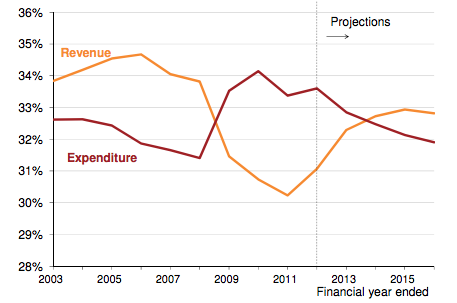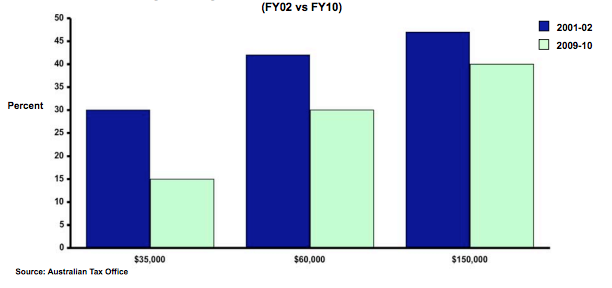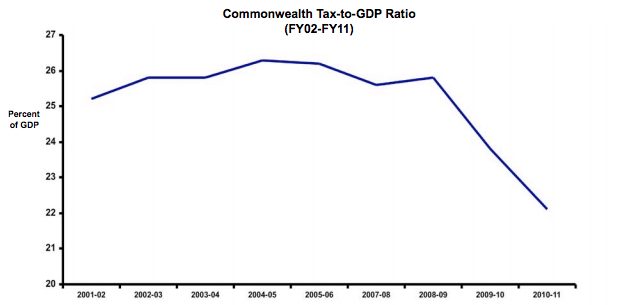All of a sudden, fiscal reality has dawned on Australia. After a decade of fat times, in which money poured into state and federal treasuries faster than politicians could spend it, our political class has woken up with a hangover and an empty wallet. We really need a coffee and a greasy breakfast, but morning-after remorse has set in.
Australia has a case of the budget blues. Actually, the country has been running deficits for years through the global financial crisis and its aftermath, but it's only been recently that we've realised things are worse than we think.
The bad news has come gradually, then all in a rush. As recently as November, the Gillard government was holding fast to its promise of a budget surplus. In 2009, when Kevin Rudd and Wayne Swan announced Labor's stimulus package, the plan was for a temporary splurge to prop up the economy, followed by a quick return to surplus once the economy returned to health. But Wayne Swan was eventually forced to abandon his promise to return to surplus. This week, even more budget write-downs were announced.
It's actually not wholly Labor's fault. Labor's deficit spend was a textbook case of Keynesian stimulus, splashing the cash on $900 handouts and school halls in a highly successful program that kept the economy out of recession and saved hundreds of thousands of jobs. And, a couple of budgets ago, it also started to wind back the stimulus, returning spending to levels roughly similar to those at the end of John Howard's reign. The problem is, that won't be enough.
The chart below, from the Grattan Institute, tells the story. It combines spending and revenue from all the states and territories with that of the feds. In the boom years of the later Howard government, revenue ran far ahead of governments' capacity to spend it. All that ended with the GFC, as revenue fell off a cliff. Simultaneously, the federal government spent up big in 2009 to keep Australia out of recession. But while spending is expected to gradually return to Howard government levels, tax revenue is not.

What's happened? Australia's “structural deficit” has been exposed. While the economy has returned to something approaching “trend growth”, as the Treasury boffins call it, tax revenue has not. Corporate tax revenue collapsed in 2008, and while it did recover again in 2011, it hasn't bounced back to 2007 levels. Maybe it never will.
The reasons are varied. The GFC obviously hurt profits; companies that recorded big losses in the downturn were then able to carry forward these losses to offset future tax liabilities. The big mining companies were also able to bank huge tax credits, this time from their vast investments in new infrastructure. And some sectors of the economy have never recovered from the GFC, bumping along in near-recession as a result of suppressed consumer demand and the sky-high Aussie dollar. In retail, for instance, the “new normal” has seen cautious consumers save far more of their disposable incomes then they used to, crimping sales. In manufacturing, the dollar is rapidly destroying whole industries. Finally, the government's attempts to raise new revenue with the carbon tax and the MRRT have yielded precious little new money.
Meanwhile, income tax rates have been slashed. As think tank Per Capita pointed out last year in a perceptive paper entitled After The Party: How Australia Spent Its Mining Boom Windfall, between 2001 and 2009, ordinary taxpayers enjoyed eight consecutive income tax cuts. The orgy of tax cutting culminated in the 2007 election campaign, when John Howard and Kevin Rudd competed to offer tax cut promises worth more than $30 billion over the forward estimates. This chart below shows just how far tax rates have fallen.

As a result of all this tax relief, Australia's taxpayers are simply paying less tax than they used to, even at the top end above $150,000 (remember that the next time you hear a politician that feels your pain about the cost of living). The big cut in income taxes has had a number of consequences. Firstly and most obviously, it has reduced federal tax revenues. Secondly, it has reduced bracket creep. One of the things that Labor did as part of its tax cuts was to flatten the tax scales, with most taxpayers now on a flat 30 per cent. This means that the government collects less revenue as taxpayers drift into higher tax brackets.
Taken together, all of these changes have made Australia's tax system far more cyclical. In boom times, when commodity prices and corporate profits are high, the tax revenue flows. But when the going gets tough, tax revenue disappears quickly. The chart below, also from Per Capita, shows how tax revenues dropped off after the boom.

Self-evidently, this is not a great way to run a modern economy. As the Grattan Institute warned in a major paper released this week, the federal and state governments have no shortage of fiscal challenges in the years and decades ahead. While governments' incomes are increasingly lumpy, their expenditures are generally ongoing and growing. Public services like health and education are expensive, and their costs tend to rise faster than the economy as a whole. Much of the heat of the recent debate about schools funding, for instance, can be traced back to the fact that cost inflation for schools funding is running at above 7 per cent. Similarly, the Grattan paper says health costs are also rising unsustainably, driven by longer lifespans and a growing tendency amongst baby boomers to go to check ups and access medical services.
Governments can and do try to hold costs down, by slashing staff and and imposing “efficiency dividends” from time to time. For instance, the federal government has slashed tens of billions in spending in recent budgets from portfolios such as defence and higher education. It has also moved to close tax loopholes in superannuation and private health. But at some point the nips and tucks turn into amputations, and governments have to make hard decisions about what services they are able to provide. We are arguably approaching this point in the defence budget, which is now at its lowest level as a share of the economy since 1938.
The recent record of the Gillard government is a case in point. Despite the Opposition's effective attacks on it as a spendthrift, the Government has in general been very responsible, cutting spending and raising taxes to fund new measures like Gonski and the National Disability Insurance Scheme. But the numbers still don't add up, because the Government simply doesn't raise enough tax.
And that's the hard truth of Australian politics in 2013. The easy money has run out, and there's no prospect of another big windfall. Governments wanting to deliver new promises, or even just to live within their means, are going to have to find ways to raise more revenue. We voters had better get used to it. We're not paying enough tax to fund the public services we say we need.
Donate To New Matilda
New Matilda is a small, independent media outlet. We survive through reader contributions, and never losing a lawsuit. If you got something from this article, giving something back helps us to continue speaking truth to power. Every little bit counts.



